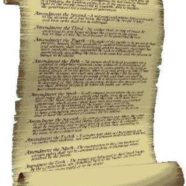A Bill of Gender Rights and a Declaration of Independence
©2016 by Dallas Denny
A Bill of Gender Rights and a Declaration of Independence
Dallas Denny
In March 1991 a remarkable document appeared in the mailbox of AEGIS, the nonprofit American Educational Gender Information Service and other transgender organizations. It was titled A Bill of Gender Rights. Trans activist JoAnn Roberts was the author.
JoAnn was opening a dialog: “Some may ask, ‘Who are you to decide these things? How dare you speak for us.’ My reply is this, ‘I dare it because it must be dared—by someone, at least—if only so that wiser minds can argue with my choices, and by arguing, clarify my vision.'”
Jo’s document specified four rights, each amplified by a few sentences:
- The right to choose a gender role
- The right to freely express a gender role
- The right to make one’s body congruent with gender role
- The right to sexual expression congruent with gender role
Two weeks after JoAnn’s Bill of Gender Rights the Gender Alternatives League issued The Gender Activist Declaration of Independence, which also showed up in AEGIS’ mailbox. It was in some ways similar to JoAnn’s earlier document, stating:
We are members of the human race and are of every religious need, color, nationality, ancestry, physical condition, social status, marital status, age, gender, sex, and sexual orientation.
However, its third clause adhered to a gender binary JoAnn’s document had not:
Our community is composed of people who wish to emulate the opposite gender or become members of the opposite sex. It also includes their spouses, domestic partners, relations, friends and associates.
Of course a lot of trans and gender nonconforming people today don’t want quite that, but even in 1991 it seemed a bit old school.
The document also pretty much crammed GAL’s (unfortunate acronym, that!) idiosyncratic terminology down the community’s throat:
Those people in our community who are not mentally ill, who forsake the old labels, who reject the old standards of allowing denigration and discrimination against our community, who choose to fight for their freedom and rights, and the freedom and rights of others, shall be known simply as “GENDERISTS.”
Genderist was GAL’s preferred term, and no one else, or at least no one I knew, seemed to use it.
My copies of the League’s newsletters now reside in the Labadie Collection at the University of Michigan and internet searches didn’t turn up any information about the organization, but thanks to the Digital Transgender Archive, I was able to determine the name of the League’s executive director and the organization’s location (later did I realize both had appeared in Chrysalis). In Joann Roberts’ The Iconoclast column in the October 1991 issue of Renaissance News, she wrote this:
NAPA CALIF. – The sounds of silence … After a lot of ballyhoo, the folks at the Gender Alternatives League (GAL) seem to have quieted down. In fact, it’s too quiet. Linda Buten, who leads the Congress of Reps for IFGE, wrote me asking if there was any way to combine the Bill of Gender Rights with GAL’s declaration so the Congress could vote on one document. I told Buten that I wrote to GAL executive director Cynthia Howard several times with suggestions for adding the bill to GAL’ s declaration, but she never replied. Hmmm! Can this be another case of NIH? Is this the new “umbrella organization” we’ve been waiting for. I think not. Quel domage.
NIH, by the way, is an acronym for Not Invented Here. I’m not sure what happened between GAL and the trans community after the organization released their document to create a hubbub. If you are reading this and remember what transpired, please leave a comment and enlighten me.
I’m happy to say I immediately realized the importance of both documents and slated them for publication in AEGIS’ journal Chrysalis Quarterly. I wanted to highlight them, so they appeared side by side in the centerfold of the second issue, printed on parchment paper with a calligraphic font to give them a look of antiquity, as if they were the handwritten U.S. Declaration of Independence and the Bill of Rights section of the U.S. Constitution. Perhaps I got the idea because the Gender Activist Declaration had been printed on yellow paper.
With a few exceptions the trans community embraced both documents. Two years later JoAnn’s vision of other voices being added to hers happened in Houston at the second International Conference on Transgender Law and Employment Policy. An International Bill of Gender Rights, which was based upon JoAnn’s and a second document by Sharon Stuart, was formalized. I wasn’t present, but I’m happy to say I was at the 1994 conference when the Bill was updated. I believe the International Bill of Gender Rights was last updated in 1996.
Just as the UN’s 1948 Universal Declaration of Human Rights and the World Association for Sexual Health’s Valencia Declaration of Human Rights (which did not arrive until 1997), The International Bill of Gender Rights is an important document for trans and gender nonconforming people, as it affirms our right to be ourselves. This is of course the crux of the conflict between us and fundamentalist Christians and other right-wing people who would deny us that right.
Joann Roberts’ Bill of Gender Rights (1991) (PDF)
Gender Activist Declaration of Independence (1991) (PDF)
Chrysalis Quarterly Pages (PDF)
(In the magazine the documents were presented side-by-side in the centerfold)
Report from the International Bill of Gender Rights (1993) (PDF)
International Bill of Gender Rights (1996 Revision) (PDF)
Universal Declaration of Human Rights (1976 Revision) (PDF)
Valencia Declaration of Sexual Rights (2014 Revision) (PDF)







0 Comments
Trackbacks/Pingbacks